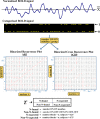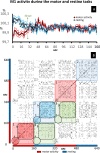Studying the functional connectivity of the primary motor cortex with the binarized cross recurrence plot: The influence of Parkinson's disease
- PMID: 34097691
- PMCID: PMC8183987
- DOI: 10.1371/journal.pone.0252565
Studying the functional connectivity of the primary motor cortex with the binarized cross recurrence plot: The influence of Parkinson's disease
Abstract
Two new recurrence plot methods (the binary recurrence plot and binary cross recurrence plot) were introduced here to study the long-term dynamic of the primary motor cortex and its interaction with the primary somatosensory cortex, the anterior motor thalamus of the basal ganglia motor loop and the precuneous nucleus of the default mode network. These recurrence plot methods: 1. identify short-term transient interactions; 2. identify long-lasting delayed interactions that are common in complex systems; 3. work with non-stationary blood oxygen level dependent (BOLD) data; 4. may study the relationship of centers with non-linear functional interactions; 5 may compare different experimental groups performing different tasks. These methods were applied to BOLD time-series obtained in 20 control subjects and 20 Parkinson´s patients during the execution of motor activity and body posture tasks (task-block design). The binary recurrence plot showed the task-block BOLD response normally observed in the primary motor cortex with functional magnetic resonance imaging methods, but also shorter and longer BOLD-fluctuations than the task-block and which provided information about the long-term dynamic of this center. The binary cross recurrence plot showed short-lasting and long-lasting functional interactions between the primary motor cortex and the primary somatosensory cortex, anterior motor thalamus and precuneous nucleus, interactions which changed with the resting and motor tasks. Most of the interactions found in healthy controls were disrupted in Parkinson's patients, and may be at the basis of some of the motor disorders and side-effects of dopaminergic drugs commonly observed in these patients.
Conflict of interest statement
The authors have declared that no competing interests exist.
Figures








Similar articles
-
The influence of Parkinson's disease on the functional connectivity of the motor loop of human basal ganglia.Parkinsonism Relat Disord. 2019 Jun;63:100-105. doi: 10.1016/j.parkreldis.2019.02.031. Epub 2019 Feb 27. Parkinsonism Relat Disord. 2019. PMID: 30833228
-
The Cerebral Network of Parkinson's Tremor: An Effective Connectivity fMRI Study.J Neurosci. 2016 May 11;36(19):5362-72. doi: 10.1523/JNEUROSCI.3634-15.2016. J Neurosci. 2016. PMID: 27170132 Free PMC article.
-
The organization of the basal ganglia functional connectivity network is non-linear in Parkinson's disease.Neuroimage Clin. 2019;22:101708. doi: 10.1016/j.nicl.2019.101708. Epub 2019 Feb 3. Neuroimage Clin. 2019. PMID: 30763902 Free PMC article.
-
Imaging of Motor Cortex Physiology in Parkinson's Disease.Mov Disord. 2018 Nov;33(11):1688-1699. doi: 10.1002/mds.102. Epub 2018 Oct 2. Mov Disord. 2018. PMID: 30280416 Free PMC article. Review.
-
The functions of the basal ganglia and the paradox of stereotaxic surgery in Parkinson's disease.Brain. 1994 Aug;117 ( Pt 4):877-97. doi: 10.1093/brain/117.4.877. Brain. 1994. PMID: 7922472 Review.
Cited by
-
Recurrence-Based Synchronization Analysis of Weakly Coupled Bursting Neurons under External ELF Fields.Entropy (Basel). 2022 Feb 3;24(2):235. doi: 10.3390/e24020235. Entropy (Basel). 2022. PMID: 35205531 Free PMC article.
-
Case report: High-frequency repetitive transcranial magnetic stimulation for treatment of hereditary spastic paraplegia type 11.Front Neurol. 2023 May 18;14:1162149. doi: 10.3389/fneur.2023.1162149. eCollection 2023. Front Neurol. 2023. PMID: 37273711 Free PMC article.
-
Cholinergic Receptor Modulation as a Target for Preventing Dementia in Parkinson's Disease.Front Neurosci. 2021 Sep 20;15:665820. doi: 10.3389/fnins.2021.665820. eCollection 2021. Front Neurosci. 2021. PMID: 34616271 Free PMC article. Review.
References
Publication types
MeSH terms
LinkOut - more resources
Full Text Sources
Medical

